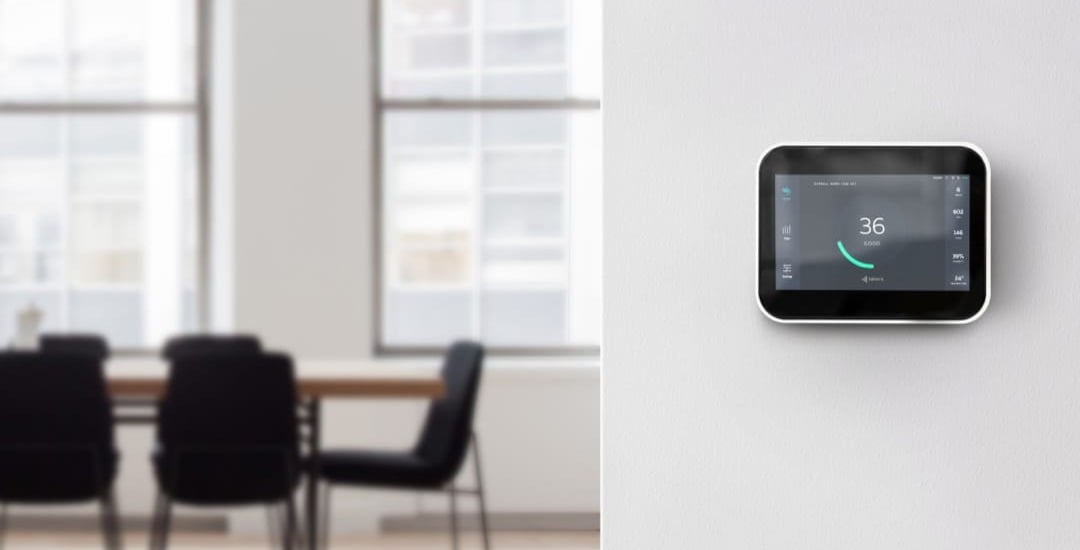Newsletter
If you’re here because you’ve got questions about the ‘coverage area’ of your air quality monitors, how many monitors you need on your premises, or where to install them, then you’ve come to the right place. In this article, we’ll look at ‘coverage areas’, monitor density, and offer some guidance on how to get the most accurate readings from your IAQ monitors.
The Myth of the ‘Coverage Area’
We get a lot of questions about the ‘coverage areas’ of IAQ monitors. The first thing you should know is that, in one sense, there is no such thing. Think of a thermostat. It can give you a fairly accurate reading of the temperature in the room, but it only measures the temperature of the air that directly comes in contact with it. If the thermostat is in the hallway, but the bedroom is freezing, the device has no way of picking up this information.
IAQ monitors work exactly the same way. They can only measure the quality of air that they come in contact with. They are effective because the air that they sample is roughly representative of the air nearby. This is because gasses naturally distribute themselves throughout a space, although some are denser at different heights. Air also tends to circulate in response to ventilation, heat, or movement, so that your IAQ monitor is usually measuring a different sample at any given time.
The problem is that air can’t easily bypass physical barriers, so your monitor will better represent the air six yards in front of it than six inches behind it, on the other side of the wall. Other factors like window drafts can also affect accuracy. For these reasons, instead of ‘coverage’, we prefer to talk about monitor density and placement guidelines based on established standards, such as the WELL performance rating and RESET Air.
Monitor Density
Monitor density simply means the amount of monitors in a given space. The more IAQ monitors strategically placed in a premises, the better the picture given by their combined readings. Various organizations have issued guidelines about monitor density. Those issued by verified building standards institutes carry extra weight because following them can help you get accredited. The following organizations have issued guidelines:
WELL v2
The Well v2 is a highly regarded and comprehensive building standard issued by the International WELL Building Institute (IWBI). This standard has ten focus areas that include air, light, thermal comfort, and sound, among others. To get accredited with the Well v2, you will need:
- Projects with occupiable space of < 3,250 m2 (35,000 ft2): 1 monitor per 325 m2 (3,500 ft2) in occupiable spaces (minimum 2)
- Projects with occupiable space of 3,250-25,000 m2 (35,000-269,100 ft2): 1 monitor per 500 m2 (5,400 ft2) in occupiable spaces (minimum 10)
- Projects with occupiable space of > 25,000 m2 (269,100 ft2): 1 monitor per 1,000 m2 (10,800 ft2) in occupiable spaces (minimum 50)
Read more about achieving WELL through IAQ optimizations.
LEED v5
The Leadership in Energy and Environmental Design (LEED) Certification is the most widely recognized certification for green building. The latest version (v5) of LEED, released in early 2025 by the U.S. Green Building Council (USGBC), places a stronger emphasis on continuous IAQ monitoring to ensure the health and well-being of the building’s occupants. LEED v5 BD+C projects can earn up to three points across two credits with IAQ monitors, while O+M projects can score up to 10 points via the Indoor Air Quality Performance Credit by installing continuous monitors.
In order to achieve these points, LEED v5 projects must comply with the following density requirements:
- At a minimum, one monitor should be placed every 25,000 ft2 (2,500 m2).
- Ideally, projects should install one monitor per 5,000 ft2 (500 m2).
- Monitors must be placed 3-6 ft (0.9-1.8 m) above the floor to capture air in the breathing zone.
- If possible, install monitors at least 3 ft (0.9 m) away from doors, windows, air filters, air supply outlets, exhaust intakes, stoves, printers, and any other sources of air contaminants.
In addition to installing monitors at the correct density in each space, LEED v5 also recommends that monitors be placed in certain locations to ensure projects gain a comprehensive picture of IAQ throughout the entire building, including on different floors, across different HVAC zones, in different types of spaces, and in areas that are prone to having worse IAQ.
Learn more about what’s new in LEED v5 and how to maximize your points for IAQ.
RESET Air
The RESET Air building standard is specifically designed to reward and promote the use of IAQ monitors for improving the health and wellbeing of occupants. This standard is unique in that it emphasizes continuous monitoring, and you can lose certification if monitoring stops while business continues. Meeting this standard requires that you:
- Only use RESET-accredited IAQ monitors, and practice continuous monitoring.
- Deploy one monitor for each regularly occupied space type (any space type that is occupied for at least one hour per day).
- Install at least one monitor per 5382 ft² (500 m²).
- Ensure that your monitors are 36-71 in (900-1800 mm) above the floor.
- Keep IAQ monitors at least five meters from doors, windows, fresh-air diffusers, and air filters. If the space is too small to achieve this, the monitor should be closer to the return than the diffuser.

What to Consider When Mapping Out IAQ Sensors
Integrating IAQ sensors into your existing environment can be challenging if you're not familiar with what to look out for. The following considerations will help you take the best path to effectively mapping out your sensors:
Breathing Zone
Some gasses are heavier than others and you may find different concentrations at different heights. However, it’s most important to know what people will be taking into their lungs. For instance, airborne dust is usually densest near the floor, but not many people do their breathing at floor level. We recommend that our IAQ monitors are installed 3-6 feet (0.9-1.8 meters) from the floor. This height range is what we call the ‘breathing zone’, as it encompasses where a person’s head will typically be if they are sitting or standing.
Windows and HVAC Systems
A window draft may cause external air to circulate around one part of a room, while another part stagnates. It might only be in winter that you close your windows and realize that your air quality wasn’t half as good as you thought it was. Placement too close to air filters and diffusers can likewise cause IAQ monitors to read air that comes from outside a space, and not the space itself. To prevent this from happening, we recommend that you place monitors at least 16 feet (5 meters) from operable windows, air filters and diffusers. If this isn’t possible, the IAQ monitor should be at least half of the space away from a window, and closer to a return than a diffuser.
Population
IAQ monitors are there to protect people, but large concentrations of staff release a lot of Co2 and can deplete oxygen levels in a poorly ventilated workspace, leading to reduced productivity and feelings of tiredness. For instance, a recent study showed that office workers worked up to 60% faster in low Co2 environments. If an IAQ monitor is too far from where people gather, it won’t register Co2 build-up or properly represent the air that they are breathing. For this reason, we suggest placing your IAQ monitors in central locations and prioritizing your most highly populated spaces.
Our Guidelines
Although neither thermostats, nor your IAQ monitor has what’s sometimes called a ‘coverage area’, there are many strategies to ensure they give you an accurate representation of the air in your workspaces.
Here is a quick breakdown of Kaiterra’s placement and density guidelines for the most common scenarios you may encounter in your building:
- If your building has multiple floors, place monitors on each floor for a full-building view of your IAQ.
- If you have different HVAC systems, be sure to install monitors in locations that are served by each system.
- If you have multiple types of spaces, spread your monitors throughout each type of space (in a commercial building, this could include conference rooms, common areas, quiet workspaces, break rooms, etc).
- If you have spaces that have higher concentrations of air contaminants, whether it’s due to high occupancy, cooking, construction work, etc., place more monitors in these spaces to make sure you’re maintaining a healthy environment throughout.
- For spaces that are frequently occupied by vulnerable populations, install additional monitors to not only proactively correct air quality issues but also verify that you are providing a space with clean air.
At Kaiterra, we advise against a one-size-fits-all approach, as each project and space is unique and will require a different strategy for monitor density. WELL , LEED v5, and RESET guidelines are a good place to start, but consider them only a starting point. The best approach is to talk to a professional who can help you identify the proper density and placement of your monitors based on your project's details.
Need help mapping out your air quality monitors in your space? Our team is always happy to review your IAQ plan and provide our recommendations!






.png?width=200&height=148&name=Menu%20C%20(2).png)

.png?width=307&height=228&name=Menu%20-%20D%20(1).png)
.png)






